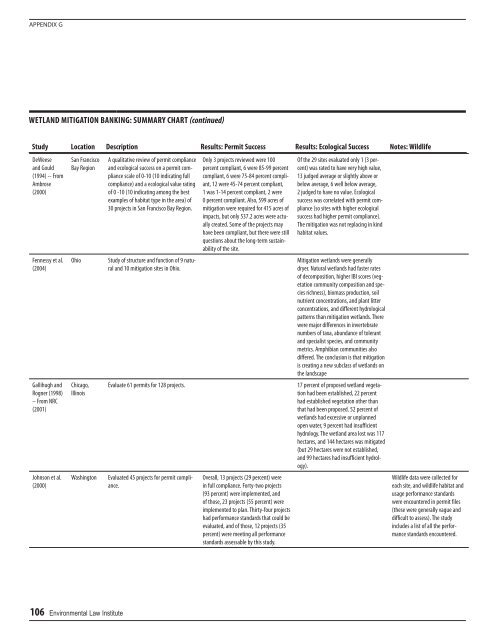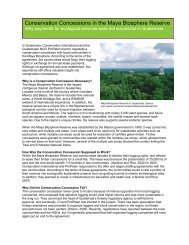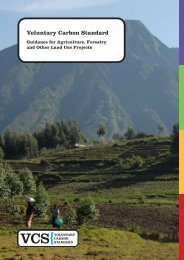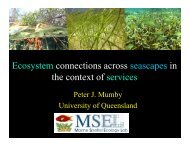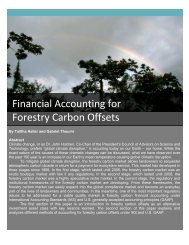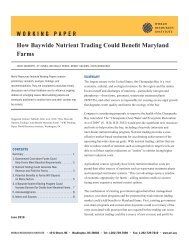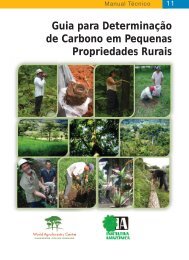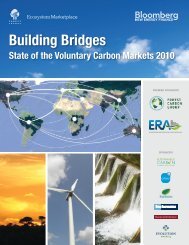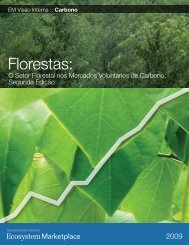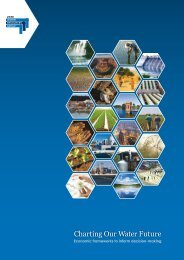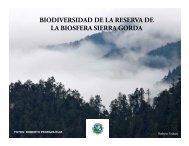Design of US Habitat Banking Systems to Support the Conservation ...
Design of US Habitat Banking Systems to Support the Conservation ...
Design of US Habitat Banking Systems to Support the Conservation ...
Create successful ePaper yourself
Turn your PDF publications into a flip-book with our unique Google optimized e-Paper software.
APPENDIX GWETLAND MITIGATION BANKING: SUMMARY CHART (continued)Study Location Description Results: Permit Success Results: Ecological Success Notes: WildlifeDeWeeseand Gould(1994) -- FromAmbrose(2000)Fennessy et al.(2004)Gallihugh andRogner (1998)– From NRC(2001)Johnson et al.(2000)San FranciscoBay RegionOhioChicago,IllinoisWashing<strong>to</strong>nA qualitative review <strong>of</strong> permit complianceand ecological success on a permit compliancescale <strong>of</strong> 0-10 (10 indicating fullcompliance) and a ecological value rating<strong>of</strong> 0 -10 (10 indicating among <strong>the</strong> bestexamples <strong>of</strong> habitat type in <strong>the</strong> area) <strong>of</strong>30 projects in San Francisco Bay Region.Study <strong>of</strong> structure and function <strong>of</strong> 9 naturaland 10 mitigation sites in Ohio.Only 3 projects reviewed were 100percent compliant, 6 were 85-99 percentcompliant, 6 were 75-84 percent compliant,12 were 45-74 percent compliant,1 was 1-14 percent compliant, 2 were0 percent compliant. Also, 599 acres <strong>of</strong>mitigation were required for 415 acres <strong>of</strong>impacts, but only 537.2 acres were actuallycreated. Some <strong>of</strong> <strong>the</strong> projects mayhave been compliant, but <strong>the</strong>re were stillquestions about <strong>the</strong> long-term sustainability<strong>of</strong> <strong>the</strong> site.Of <strong>the</strong> 29 sites evaluated only 1 (3 percent)was rated <strong>to</strong> have very high value,13 judged average or slightly above orbelow average, 6 well below average,2 judged <strong>to</strong> have no value. Ecologicalsuccess was correlated with permit compliance(so sites with higher ecologicalsuccess had higher permit compliance).The mitigation was not replacing in kindhabitat values.Mitigation wetlands were generallydryer. Natural wetlands had faster rates<strong>of</strong> decomposition, higher IBI scores (vegetationcommunity composition and speciesrichness), biomass production, soilnutrient concentrations, and plant litterconcentrations, and different hydrologicalpatterns than mitigation wetlands. Therewere major differences in invertebratenumbers <strong>of</strong> taxa, abundance <strong>of</strong> <strong>to</strong>lerantand specialist species, and communitymetrics. Amphibian communities alsodiffered. The conclusion is that mitigationis creating a new subclass <strong>of</strong> wetlands on<strong>the</strong> landscapeEvaluate 61 permits for 128 projects. 17 percent <strong>of</strong> proposed wetland vegetationhad been established, 22 percenthad established vegetation o<strong>the</strong>r thanthat had been proposed. 52 percent <strong>of</strong>wetlands had excessive or unplannedopen water, 9 percent had insufficienthydrology. The wetland area lost was 117hectares, and 144 hectares was mitigated(but 29 hectares were not established,and 99 hectares had insufficient hydrology).Evaluated 45 projects for permit compliance.Overall, 13 projects (29 percent) werein full compliance. Forty-two projects(93 percent) were implemented, and<strong>of</strong> those, 23 projects (55 percent) wereimplemented <strong>to</strong> plan. Thirty-four projectshad performance standards that could beevaluated, and <strong>of</strong> those, 12 projects (35percent) were meeting all performancestandards assessable by this study.Wildlife data were collected foreach site, and wildlife habitat andusage performance standardswere encountered in permit files(<strong>the</strong>se were generally vague anddifficult <strong>to</strong> assess). The studyincludes a list <strong>of</strong> all <strong>the</strong> performancestandards encountered.106 Environmental Law Institute


